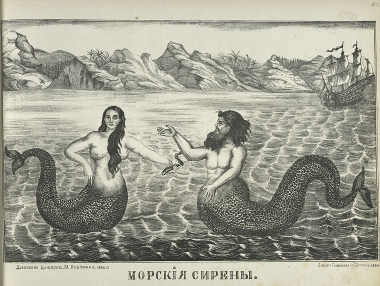By Sonya Collins (Atlanta Science Tavern contributor)
I saw a sea rabbit off the coast of Brooklyn in the summer of 2008. “Dr.” Takeshi Yamada stepped off the Coney Island boardwalk to wander among sunbathers and castle-builders offering them the chance to pet the creature. Yamada, dressed in a black three-piece suit, looked like a “doctor” who might’ve sold snake oil to unwitting tourists strolling that same boardwalk beneath parasols the year it opened in 1923.
Tucked under Yamada’s arm was a fuzzy creature with the upper body of a rabbit and a long mermaid-like tail. It was lumpy and appeared to be losing fur by the fistful, and though my fellow sunbathers and I knew better than to believe in sea-dwelling rabbits, somehow we couldn’t be sure.
We looked at the rabbit and then each other, heads inclined but unwilling to give voice to the words inside our heads: Is that real? There wasn’t unanimous laughter, or “How’d you make that?” In spite of ourselves, for at least a moment, we were willing to believe.
But why? What makes reasonable people willing to believe they’ve seen Nessie, Big Foot or – perhaps a distant cousin of the sea rabbit – a mermaid?
Sometimes, says anthropology researcher Nick Sucik, it just takes one outlying circumstance. Sucik has lived among diverse people to study the mythical creatures they believe in and to understand why.
The year I saw the sea rabbit, Sucik was on the Scottish island of Benbecula, searching for a storied mermaid grave. You’ll have to read about the outcome of Sucik’s search in the UK’s Fortean Times in a couple of months, but he did share his thoughts as to why an entire island came to believe they’d seen a mermaid.
The Benbecula Mermaid story was first recorded in the Carmina Gadelica, a multivolume collection of Scottish prayers and folktales compiled by Alexander Carmichael in 1910.
Carmichael wrote: Some seventy years ago, people were cutting seaweed at […] Benbecula. […] One of the women […] saw a creature in the form of a woman in miniature, some few feet away. Alarmed, the woman called to her friends, [who] rushed to the place.
The creature made somersaults. Some men waded into the water […], but she moved beyond their reach. Some boys threw stones […]; one […] struck her in the back. A few days afterwards, this strange creature was found dead […] nearly two miles away.
[Her upper body] was about the size of a well-fed child […], with an abnormally developed breast. The hair was long, dark, and glossy; the skin was white, soft […]. The lower […] body was like a salmon, but without scales. Crowds, some from long distances, came to see this strange animal, and all [agreed] that they had gazed on [a] mermaid.
Mr. Duncan Shaw, […] sheriff of the district, ordered a coffin and shroud be made for the mermaid […]. The body was buried in the presence of many people […]. There are persons still living who saw and touched this curious creature, who give graphic descriptions of its appearance.
The mermaid’s funeral is said to be one of the most widely attended events in Benbecula’s history. “People rarely ventured away from their cottages,” Sucik said. “But now they traveled from all over the island.” That the sheriff ordered a coffin and shroud – costly items – was also noteworthy. The “mermaid” – an unbaptized foreigner – “was given a celebrity burial,” Sucik said.
Images of mer-people span cultures and history from the ancient Greek Triton to Inuit carvings of a fish with a woman’s face, Sucik says. Many written accounts of mermaid sightings are later chalked up to “cases of mistaken identity.” What settlers described as a merman off the coast of Virginia in 1676 historians now believe was a bearded seal described by people who had never seen one before.
“You’re seeing a creature in the water with the upper body bobbing upright above the surface. It’s not moving like an animal in the way that you’re used to, but swimming towards you, facing you, with those forward-facing eyes. For someone who’s never seen a seal, it has a presence that reminds you of a person,” Sucik says.
Other accounts of mermaids, Sucik is certain, have simply described women swimming in the nude. But because it was uncommon in the times of the sightings for people to know how to swim, the sight of a human swimming, combined with the shock of that human being a naked woman, pushed the viewer to take such a leap as to believe he’d seen a mermaid.
In these descriptions, the maidens always disappear under the water when spied by an onlooker. But if you were swimming naked, wouldn’t you?
“Especially in traditional societies, like on the islands, it’s so easy and common for folks, instead of looking for a more plausible explanation, to take huge leaps,” he says.
Sucik has traveled to Native American reservations to understand one group’s belief in a winged snake and another’s belief that an African lion walked among them here in North America.
“A lot of these stories have a mundane explanation that we’ve taken out of context,” he says. “It all seems like innocent fun, but it gets to a point where people don’t believe in global warming or they think that vaccines give kids autism because they’ve been subscribing to this sort of pseudoscience.”
A Google search revealed to me that Dr. Yamada was the Dr. Frankenstein of taxidermy. His Brooklyn art studio is filled with faux-offspring of the oddest couples of the animal kingdom – an explanation only slightly less bizarre than just believing in sea rabbits.
Sonya Collins is an independent journalist covering health care, medicine and science. She is a regular contributor to WebMD and Yale Medicine Magazine and the editor of the Georgia Public Health News Bureau.

